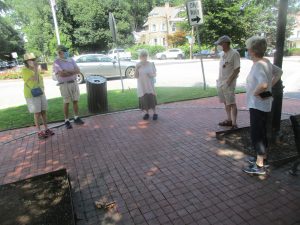Octogenarian Protester Rekindles Spirit of the ‘60s to Fight for Change

In the 1960s, when Judith Schmidt was living in Greenwich Village, she protested every Saturday in support of the civil rights movement and against the Vietnam War.
She would stand on Sixth Avenue in lower Manhattan with countless others holding signs, trying to make a difference with her silence and her presence.
Schmidt, now 86 years old, doesn’t have the strength and endurance to participate in today’s protests for racial equality. But she can still stand and send a message.
Reaching back more than a half-century, she has recently started a mostly silent hour-long vigil in the median on Bedford Road in Katonah halfway across the street from the Katonah Village Library from 2 to 3 p.m. every Saturday regardless of the weather.
“What I’m really hoping for is I’d like to reach out to Antioch Baptist Church and have black and white people stand there together and to make a visible statement for taking up the unfinished work during the civil rights days,” said Schmidt with a handmade sign draped around her neck that read “Justice Justice Justice.”
On July 18, about 15 to 20 people joined Schmidt. Last Saturday, on a near 90-degree day that was made relatively comfortable by the shade from trees, a less robust five or six people showed up.
She has reached out to Rev. Melissa Boyer, the pastor at the Katonah United Methodist Church, who plans on getting some of her parishioners involved and to contact other area houses of worship in hopes of attracting members of the faith community to participate.
While Schmidt intends to protest every Saturday until at least Election Day, Boyer said that she’s not tying the vigil to this year’s campaign. There’s too much work to accomplish on deep-seated problems to be solved with the outcome of one election.
“This is an ongoing struggle for racial equality,” said Boyer who spent most of last week holding an “End White Silence” sign. “It started long before us and it will continue long after the election. I think a well-informed active population is what makes a democracy. So I’m not hanging my hopes on the election.”
During the hour vigil last Saturday, several passing motorists honked horns or gave a thumbs up sign. One young man stopped to ask Boyer what she meant by End White Silence.
While Schmidt, who worked with emotionally disturbed children before becoming a psychotherapist, said the impetus for her rekindled devotion to protests was the killing of George Floyd in late May.
“If I was the age I was during the civil rights movement I’d be out there in the Black Lives Matter protests, but this is what I can offer now,” she said, “and (on July 18) there was some younger people and that was beautiful.”
But another goal of the protest is recognizing and righting injustices in society whatever and wherever those may be.
Pleasantville resident Jim Zimmerman, who has known Schmidt for many years, also protested during the Vietnam War era, but by 1968 had grown disillusioned.
During the past couple of months, with many students and young adults taking to the streets, he has felt a renewed sense of belief that perhaps there can be meaningful change. He plans to attend as many Saturdays as possible not only to support a friend try to expand the effort but to initiate dialogue with anyone who might listen.
“It’s only been recently, where I feel like there was any hope,” Zimmerman said. “I tend to be really cynical, but this is starting to feel like there’s some hope that can pass some of the destructiveness and frankly insanity that we have in this country right now.”
Dale and Ellen Saltzman of Somers have been regular participants after hearing about Schmidt’s efforts. Similar to Schmidt, it’s not feasible to travel distance to go to large rallies, but they feel like they can do their part by being part of a very local effort.
“I really feel connected to everybody, everywhere and it’s part of that weaving of that thread of caring, of loving of taking a risk,” she said. If I can’t go to Portland, well I can certainly be here and I do feel we’re all connected and that’s sacred to me, and I can spare some time to let other people know that, too.”

Martin has more than 30 years experience covering local news in Westchester and Putnam counties, including a frequent focus on zoning and planning issues. He has been editor-in-chief of The Examiner since its inception in 2007. Read more from Martin’s editor-author bio here. Read Martin’s archived work here: https://www.theexaminernews.com/author/martin-wilbur2007/
